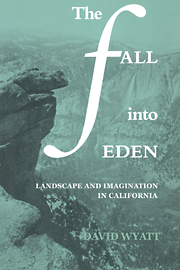Book contents
- Frontmatter
- Contents
- List of illustrations
- Acknowledgments
- Prologue: The mythology of the region
- 1 Spectatorship and abandonment: Dana, Leonard, and Frémont
- 2 Muir and the possession of landscape
- 3 King and catastrophe
- 4 Mary Austin: nature and nurturance
- 5 Norris and the vertical
- 6 Steinbeck's lost gardens
- 7 Chandler, marriage, and “the Great Wrong Place”
- 8 Jeffers, Snyder, and the ended world
- Epilogue: Fictions of space
- Notes
- Bibliography
- Index
2 - Muir and the possession of landscape
Published online by Cambridge University Press: 18 December 2009
- Frontmatter
- Contents
- List of illustrations
- Acknowledgments
- Prologue: The mythology of the region
- 1 Spectatorship and abandonment: Dana, Leonard, and Frémont
- 2 Muir and the possession of landscape
- 3 King and catastrophe
- 4 Mary Austin: nature and nurturance
- 5 Norris and the vertical
- 6 Steinbeck's lost gardens
- 7 Chandler, marriage, and “the Great Wrong Place”
- 8 Jeffers, Snyder, and the ended world
- Epilogue: Fictions of space
- Notes
- Bibliography
- Index
Summary
There is a property in the horizon which no man has but he whose eye can integrate all the parts, that is, the poet.
– Emerson, NatureJohn Muir's (1838–1914) landscapes do not remain solely the property of his eye. Forty pages into The Yosemite, landscape description has begun to prove tedious, and Muir decides to divert his readers with story. The subtitle “An Unexpected Adventure” alerts us that doing is about to supersede looking. Wishing one night “to look at the moon through the meshes of some of the denser portions” of Yosemite Falls, Muir ventures “to creep farther behind it while it was gently wind-swayed, without taking sufficient thought about its swaying back to its natural position after the wind-pressure should be removed.” Muir begins his foray from Fern Ledge, a granite shelf extending behind the fall some four hundred feet above its base. He achieves his goal, and the wind shifts.
Down came a dash of spent comets, thin and harmless-looking in the distance, but they felt desperately solid and stony when they struck my shoulders, like a mixture of choking spray and gravel and big hailstones. Instinctively dropping on my knees, I gripped an angle of the rock, curled up like a young fern frond with my face pressed against my breast, and in this attitude submitted as best I could to my thundering bath.
Trapped in the shaft of California's highest waterfall, Muir begins to weigh the chances of escape. “Would the column be swayed a few inches away from the wall, or would it come yet closer? The fall was in flood and not so lightly would its ponderous mass be swayed.”
- Type
- Chapter
- Information
- The Fall into EdenLandscape and Imagination in California, pp. 32 - 46Publisher: Cambridge University PressPrint publication year: 1986

